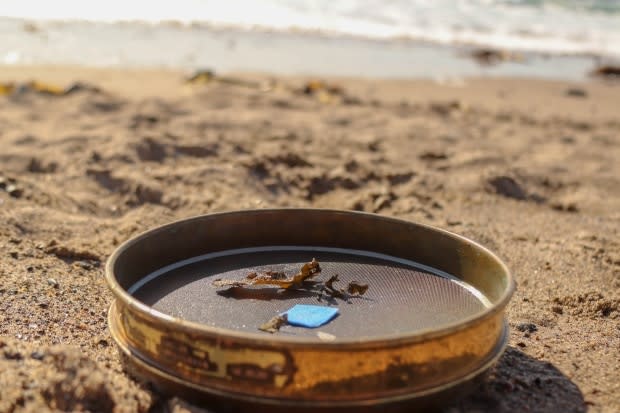Research finds fishing gear a major source of ocean microplastics in Atlantic Canada
Two years ago, researchers collected microplastics from pristine surface waters at three nearshore locations in Nova Scotia and Newfoundland, finding tiny and unrecognizable fragments, threads and fibres in every trawl.
Chemical analysis has now identified the synthetic polymers that made up those miniscule pieces of plastic and confirmed what was expected: the microplastics were shed from easily recognized sources.
"Fishing gear, fishing rope, fragments of nets and particles that would come from that kind of activity, that is a big source of microplastics," said Ariel Smith, the coastal and marine team lead for Coastal Action, the environmental group that is leading a three-year Atlantic Canadian microplastics research project.
The microplastics also come from common single-use items that people use every day, Smith said, as well as fragments from things like packaging.
"It's really important that we think of microplastics in the larger context. These microplastics don't just end up there. They didn't start as these tiny things that are less than five millimetres in size," she said.

The three-year study is funded with a $218,000 grant from Environment and Climate Change Canada. The goal is to provide a first-ever estimate of the quantity of microplastics in the ocean in Atlantic Canada.
Surface water samples were collected in Nova Scotia from the mouth of Lunenburg harbour, the LaHave River Estuary and the Annapolis Basin. They were also gathered from the Bay of Islands and Humber Arm in western Newfoundland.
The analysis found more than 20 different chemical bonds in the samples. Other findings included:
Annapolis Basin sampling sites were 15 per cent polypropylene (rope, packaging, containers), 15 per cent polyethylene (bags, cups, bottles) and 10 per cent polyethylene/terephthalate (plastic bottles, polyester).
Lunenburg County sampling sites were 16 per cent polyethylene, 15 per cent polypropylene and 13 per cent polystyrene (Styrofoam).
Humber Arm, N.L., sampling sites were 30 per cent polypropylene, 11 per cent polyethylene and eight per cent polyamide (nylon).
The study also included sampling for microplastics in beach sediment at all locations, but a chemical analysis has not been released on those samples.
'Even more than we thought we'd find,' says researcher
A recent update on the project notes microplastics are ingested throughout the food chain and can have both physical and chemical impacts on aquatic life.
Smith said she expected to see microplastics, but not on every trawl.
"It definitely was even more so than we thought we would find ... they end up ubiquitously across the marine environment," she said.
A coalition of industry, government and NGOs called the Fishing Gear Coalition of Atlantic Canada has 20 projects underway to address lost gear, from testing ropeless traps to retrieval operations.
The government of Nova Scotia acknowledges the microplastics problem, calling it "a growing global concern for all marine environments, and plastics used in fishing gear is one of a myriad of sources, as the study has noted."
Dan Davis, with the Nova Scotia Department of Fisheries and Aquaculture, said in an email the provincial government is taking steps to remove marine debris before it can break down in the environment.
"The province is a partner with other provinces and the federal government on a zero plastic waste strategy, which looks holistically at ways to reduce single use plastics and microplastics in the environment," he said.
"The province recognizes the importance of clean ocean waters and, through its new marine debris cleanup program, supports the fish and seafood industry to work in partnership with others to do beach and ocean cleanups."
Read Coastal Action's report:
MORE TOP STORIES

